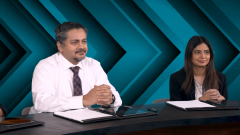
Transplant-Ineligible Multiple Myeloma: Triplet vs Quadruplet Therapy
Considerations for selecting between a conventional front-line triplet regimen to manage a patient with high-risk multiple myeloma who is ineligible for transplant vs a new quadruplet regimen, as demonstrated in recent clinical trial data.
Episodes in this series

Saad Z. Usmani, MD: When you initiate the 3-drug regimens for your newly diagnosed transplant-eligible patients, we talk about whether you continue maintenance with 1 drug vs continuing on all drugs. Does cytogenetic risk, or high risk vs standard risk, influence your pick of the triplet? How confident are you of 1 strategy vs the other: whether you continue 1 drug vs 2 drugs, even for an older patient? Sham, you want to go first?
Sham Mailankody, MD: I think we talked a lot about the ENDURANCE study, but it’s important for people to know that it’s a large study with 1000 patients but didn’t include patients with high-risk myeloma, or high-risk cytogenetics. So those patients were excluded. The results, very strictly speaking, of the ENDURANCE study, is relevant or applicable primarily to patients with standard-risk myeloma. I think the clinical scientific question about the role of carfilzomib [Kyprolis] in frontline patients with high-risk cytogenetics is still an open question.
That said, I do believe that of the many treatments for myeloma, there are very few treatments that work for high-risk patients, but do not work in standard-risk patients. It’s usually vice versa. You have treatments that work very well in low-risk patients, but do not work in high-risk. I think it’s reasonable to consider, say, carfilzomib, lenalidomide [Revlimid], and dexamethasone [KRd] for high-risk patients. I think that the responses tend to be somewhat earlier with carfilzomib vs Velcade [bortezomib]. So if you have a patient who has a large mass in the spinal column or another lesion that you would like to get early, quick responses, and has high-risk cytogenetics, I would probably lean towards KRd/carfilzomib. As I mentioned, as we’ve talked a little bit, I think a quadruplet would also be an option in those patients, based on emerging data from the GRIFFIN study. Again, these studies have not looked specifically at high-risk patients, which is what limits us being more definitive, but I think it would be reasonable to consider, in those patients, daratumumab [Darzalex]/RVd [lenalidomide, bortezomib, and dexamethasone]. This is not in trials, but I guess this is how I practice. If I start on a triplet, whatever the choice is, like RVd, I check again in 2 months to see what the response is like. If you have a patient that has not achieved a PR [partial response] after 2 cycles of RVd and has high-risk cytogenetics, that patient isn’t likely going to get a very deep response. Those are patients who I would be more proactive about adding a fourth drug or changing to a different triplet. It doesn’t happen very often, fortunately, but is something to keep in mind as we tailor these regimens and treatments to our patients.
Saad Z. Usmani, MD: Yeah. Those tend to be the more difficult primary refractory kind of patients.
Sham Mailankody, MD: Yes.
Saad Z. Usmani, MD: What do you think, Neha?
Neha Korde, MD: Yeah. Very similar to how Dr Mailankody practices I would say. I tend to be a little more forward in the high-risk young population. I would probably go with my quadruplet up front these days, but KRd also certainly works in those patients. For my elderly patients, again, that are transplant eligible, I tend to still do daratumumab/RVd for those patients. For my transplant-ineligible group, honestly, within my practice, I probably just do daratumumab/RD, or RD at this point. I have played around with a daratumumab/RVd-lite [lenalidomide, bortezomib, dexamethasone] combo, kind of doing a little bit of both. In the transplant ineligible setting, it really depends on who’s sitting in front of me, and what the patient looks like.
Saad Z. Usmani, MD: Urvi, what do you think?
Urvi Shah, MD: I think they’ve answered it really well.
Saad Z. Usmani, MD: You can say thumbs up guys. I agree with both of you.
Transcript edited for clarity.
Newsletter
Stay up to date on recent advances in the multidisciplinary approach to cancer.





















































































